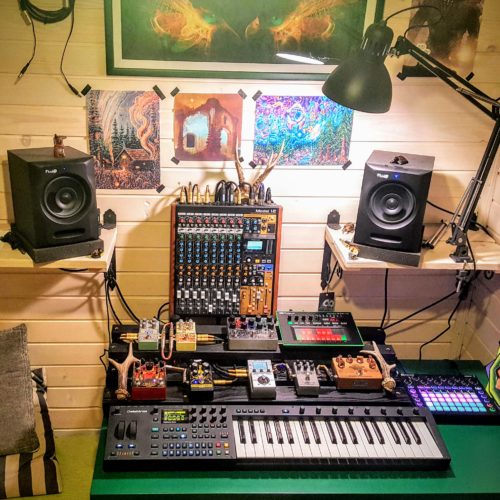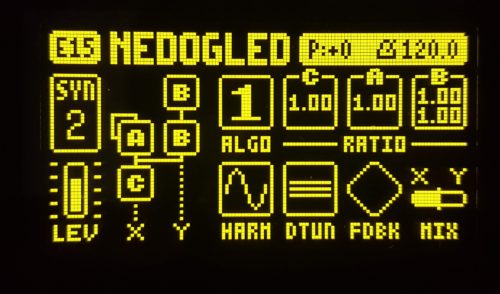The typical brain of any music production setup these days is undoubtedly a PC running either Windows or Mac. However, those of us running DAWless setups for composing and recording need some central piece of gear that will provide the bulk of the sounds we need, and serve as the control center for playing and sequencing other gear.
I started off with a Novation Circuit in order to get a better feel for my long term needs, which turned out to be the following:
- Diverse sound design – enough flexibility to produce almost any sound I think up, even if it means climbing a steep learning curve
- Multitimbrality – ability to play more than one timbre/part (bass, lead, chords) at the same time
- Standalone – the only time I want to connect this piece of gear to a PC is when doing backups or firmware updates
- MIDI sequencer – for controlling external synths and drums
- Decent keyboard – full size and aftertouch would be nice
Once all that was in the clear, there was really no alternative to the Digitone Keys.

What follows is my reflection after two years of intensive studio usage, and below is the ambient EP I made immediately after getting the Digitone Keys. You can let it play in the background as you read this article for some added context. The only additional processing I used was a Digitech Polara Reverb.
The Hardware
The synth is as sturdy as any hardware I’ve ever used, and even surpasses some of the Roland gear I have in terms of build quality. The enclosure is all metal, trigger keys are mechanical, tough yet smooth encoders and a Fatar keybed – a solid 11. I would have no qualms about taking this piece of gear on the road for a live set.

People have made fun of the design choice to put the synth part next to the keyboard, instead of above. After using this setup for a while, my opinion is that more manufacturers should be doing this. It makes composing with one hand on sound design and one on the keyboard a breeze, plus there’s space to put other modules above.
The keyboard does feel limiting with only 3 octaves, especially considering that you can do voice split zones across it, but with no space to go with it. It is what it is and at least they haven’t skimped on the quality with the full sized keys and aftertouch.
The tiny screen is one of the best UI achievements I’ve seen on any piece of gear. At first glance it’s difficult to imagine the amount of options hiding behind it, but once you’re familiar with the workflow it’s a breeze to use. The screen gives the whole synth a very retro feel with a vibe of programming sounds on a small terminal.
Digital Sound Engine
Elektron describes Digitone as a Polyphonic Digital Synthesizer. To be more specific, we’re talking about 4 operator Frequency Modulation with a multimode filter, spread across 8 voices that are shared between up to 4 separate tracks. This is my first real attempt at FM synthesis, and I’m very happy with the approachability and the versatility of the sound engine. I can pretty quickly dial in a sound I need and modulate its parameters with satisfaction using the LFOs (2 per track).

The icing on the cake are the included send effects, which can be used either in series or parallel. The Chorus is stellar (Elektron’s intention was to mimic the original Roland Juno chorus, I have no idea if they succeeded), while the Delay and Reverb are utilitarian – they’ll help sounds land in the mix, but you won’t get anything fancier than pre-delay on verb and ping-pong delay.
Here is my default voice/track setup as an example:
| Track | Voices | Part | Effects | Details |
| 1 | 2 monophonic | Bassline | External Fuzz pedal | Almost always in unison for extra grit |
| 2 | 1-2 monophonic | Lead | External Delay and Reverb | |
| 3 | 2-6 polyphonic | Chords | Internal | Usually dyads in unison |
| 4 | 0-1 monophonic | SFX | Internal |
The Digitone Keys lends itself well to being used as the main brain of a setup, with only the voice count acting as a noticeable limitation. Other features worth mentioning are an excellent portamento implementation, decent arpeggiator and a ton of modulations via the pitch and mod wheels, as well as through velocity and aftertouch.
Elektron Sequencer
The added bonus of using any Elektron gear with MIDI out capabilities is the magnificent sequencer. The stars of the show are Parameter Locks (any internal or MIDI parameter can be changed at each step) and Conditional Trigs (plenty of conditional options to determine when each step of the sequencer should be triggered).

4 MIDI tracks with polyphony are plenty for controlling other gear, which for me has included Roland TB-3, Roland TR-6S and Novation Circuit. While all of the above have great sequencers (with some variations of P. Locks and C. Trigs), they are easily eclipsed by the Elektron sequencer.
Shortcomings & Issues
Now that we’ve got all the good stuff out of the way, let’s look at what could be done better on the Digitone Keys, perhaps through future updates.
Wishlist
- Effects are not sent to individual outputs, but to the master output only. This is a shame, particularly on the Keys version since it already has individual track outputs. While this is a typical setup that assumes effects will be added in the mix, it would be great to have the option of meshing the effects with each of the tracks for additional sound design capabilities.
- More voices! I’m fairly certain that this won’t happen due to DSP limitations, but worth mentioning since it prevents using all 4 tracks to their full potential. Once you get into unison with chords, the voice limitations quickly add up.
Bugs
I’ve had a couple of annoying bugs pop up during the course of using the Digitone Keys over the past year. However, all bugs seem to have been fixed in the 1.31 update. I’ll update this space if I encounter new ones or the old ones pop back up, but right now I’m in bug-free heaven!
Getting the Most from your Digitone Keys
Read the Manual!
While I think it’s useful to RTFM for any moderately complicated electronic device, it’s almost imperative you read the manual in order to get the most out of your Digitone Keys. Expecting to simply stumble upon its hidden features and deeper nuances is a fool’s errand.
Presets
There’s a big list of preset packs over at the Elektronauts forum. I’ve tried out a bunch of them, but after the initial browse and listen I rarely used them, relying instead on a couple of my own basic presets which I work from when developing a sound. However, one preset back that really stood out for me was the CO5MOS bundle.
Overbridge
One crucial feature that I haven’t mentioned, simply because I have no use for it, is Elektron Overbridge. You can use it to send multi-channel audio over USB, integrate the Digitone into a DAW via VST and other nifty features. My entire setup is based around the fact that I don’t need to fire up a PC in order to record. It’s one of the reasons why I opted for the Keys version in order to be able to record multi-channel to my Tascam Model 12 using the separate track outputs. If your situation is different, Overbridge is definitely a feature worth looking into.
Have you had a chance to play with the Digitone or some of the other Elektron gear? Share your thoughts in the comments below.
Subscribe for Blog and Music Updates
